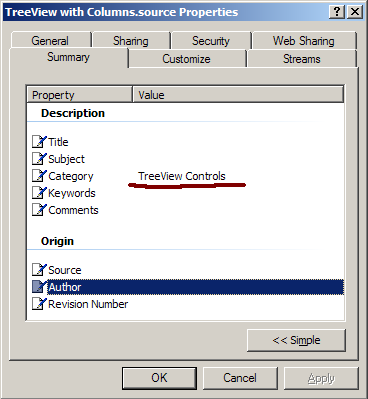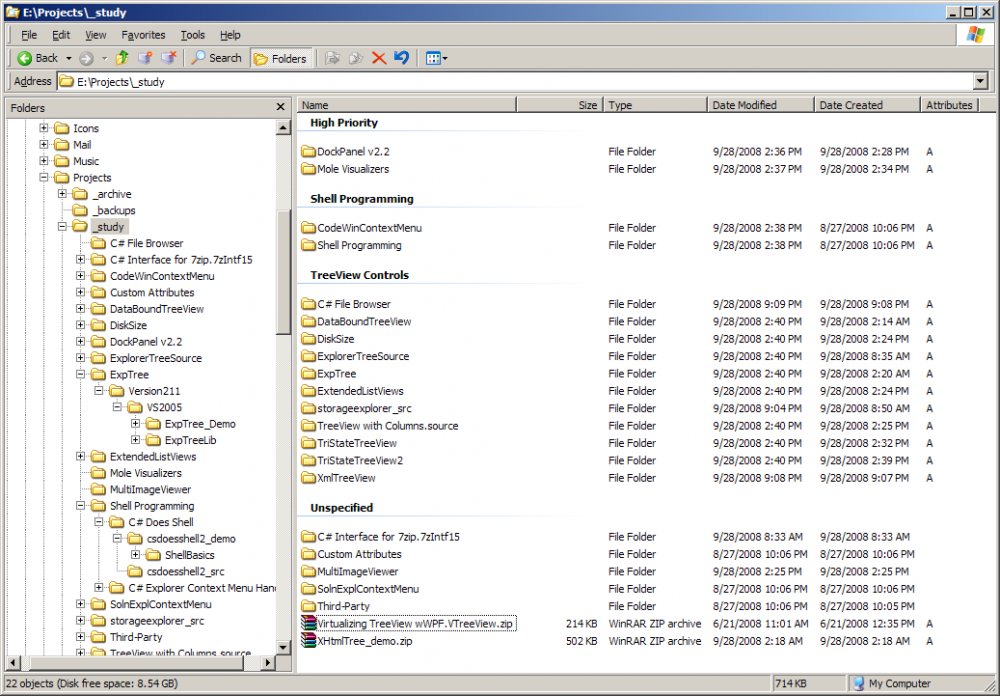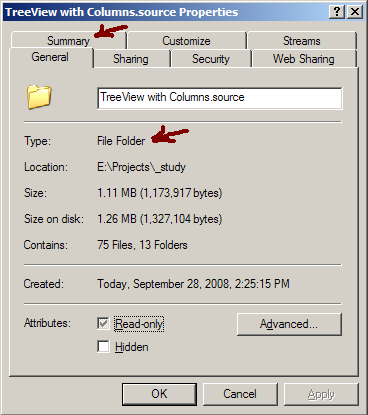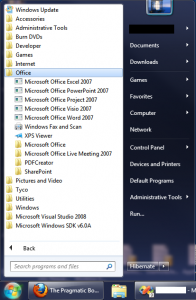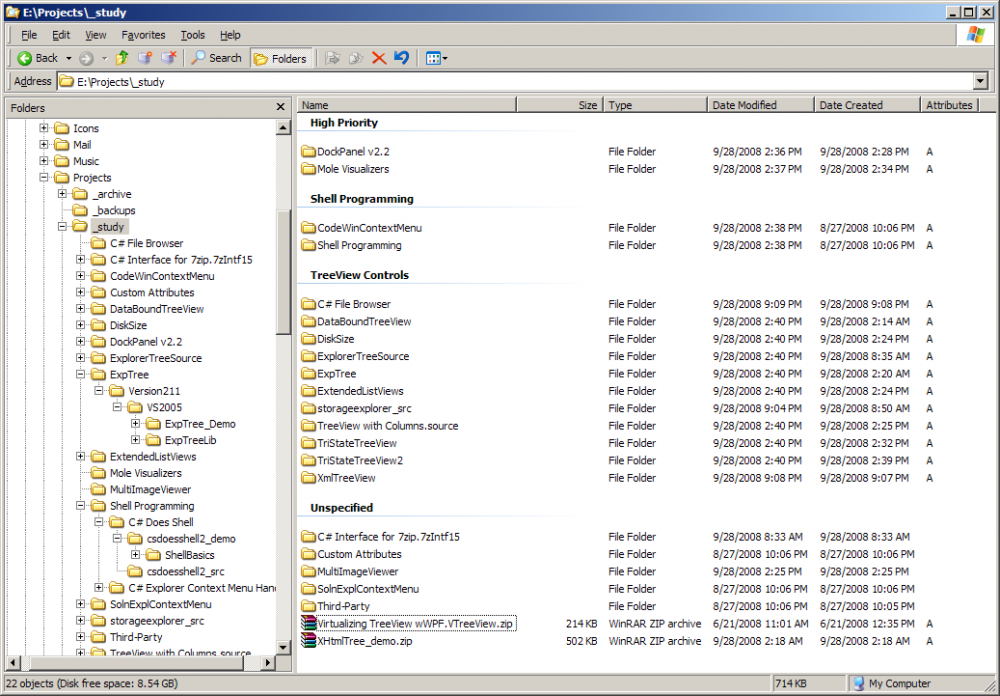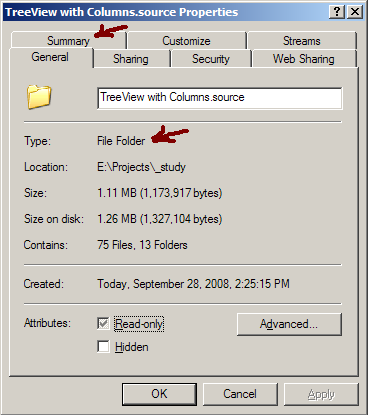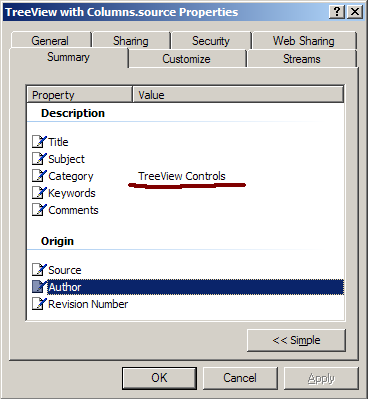Content Type
Profiles
Forums
Events
Everything posted by SngBrdb
-

Apply categories to folders in Windows Explorer
SngBrdb replied to SngBrdb's topic in Windows Tips 'n' Tweaks
When I originally posted this, you could only link to images, not upload them - the site I had them listed on is long gone. But you're in luck, I can upload them now To group by the column in Windows 7, right-click the background in Windows Explorer and click "Group By". In the list of columns displayed, check "Category". Then right-click the background in Windows Explorer and click "Group By" to select "Category", because Microsoft After that, you can right-click the headers and uncheck "Category" from the displayed columns; the Group By Category will remain. If you get this to work in Win7 or later, let me know what you had to do! . -

Why not invent a flying car instead of one manned, spaceship
SngBrdb replied to ROTS's topic in General Discussion
This post is a troll, right? I'm supposed to get sucked in and go off about people who sit on their a** in front of a computer and rave about what other people should do, making it sound as if they'd do it themselves if they could spare the 45 minutes it would take to strap a water balloon to a fan, right? Fortunately, I've spotted all the classic troll indicators – phrases like "any moron could"; perpetuating uninformed, snopes-quality stories that have no basis in facts; nonsensical sentence fragments; and a clear attempt to sound older than 13 – and so will not rise to the bait. On a side note, "penetration" does not have the same root as "penis". Not sure where your mind was, but the 'i' and 'e' keys aren't even side-by-side on a Dvorak keyboard. And since I'm calling you on such things: "there", "earth's", "already", "let's", and an occasional comma here and there. ¿Sí, sí?. -
I swear I've seen information on how to disable this, but I haven't been able to find it again - here, or anywhere else. In the Windows 7 Start Menu, as folders expand, if the names of folders or shortcuts are too long, the menu text begins to automatically side-scroll or jump left and right. This is extremely annoying and makes it hard to read as you move the mouse over the menu items. How in god's name do you disable this behavior??!?
-
cluberti> Yes! I must have overlooked it... "The system is entering sleep. Sleep Reason: Battery" But the ups didn't go down on me... I wonder if the ups is dying, sending a bad signal or not enough juice. Wonder if there's a performance counter to watch the battery... I've unplugged the usb connector to the battery for now... hopefully that will keep the battery from signaling to sleep. Stoic> That's a good thought, that hadn't occurred to me. I did just recently get a new keyboard, and this has been happening both before and after the new keyboard, so I'm inclined to think it's not that. But I will keep that on the back burner to investigate if messing with the UPS doesn't do it. Thanks, all!
-
Searched the forums, didn't find a topic on this... Windows 7, x64 Intel Core 2 Duo 4 GBs RAM Plugged into UPS Windows randomly goes to sleep/hibernates (not sure which one it is) for no apparent reason. I have everything sleep/hibernate related disabled in my power config settings. I have disabled hibernation via powercfg -hibernate off. I have edited the group policy to disable hibernating on any low or critical alarm. It continues to sleep/hibernate on me. I was here today when it did it, working on my laptop... the UPS was silent, so it wasn't in response to running on battery (normally I get shrill beeps if I'm running on battery). The last two times it slept were at 4:48 PM and 4:43 PM on different days (indicated by the signoff timestamp in Pidgin), but it does not happen every day... sometimes it will go a couple of weeks without shutting down; the last two times were within three days of each other. There's nothing in my event viewer related to hibernating... all I get are a bunch of startup-related events when it's resuming. This is driving me crazy... it kills my downloads, kicks me off IM, and generally wreaks havoc on my PC. Any ideas why Windows insists on going to sleep? Or hibernate, whichever it is?? Thanks in advance! James
-
I am sooooo getting the sh*ts of this. I have everything under system restore disabled... no previous versions, no shadow copies... but Windows 7 will occasionally roll back changes to system-related directories. I've had files removed from my desktop and lost forever. I frequently have my start menu rolled back to an earlier version. This happens on both my home and work computers. Both are running Windows 7 x64. In the attached picture you will see several start menu icons for Office 2007. More than two weeks ago, I uninstalled Office 2007, and installed Office 2010. The shortcuts you see were all shortcuts to Office 2010 apps. There is absolutely no reason for this rollback. What is going on??!? I've seen very sparse discussions of this elsewhere, so it seems to be a less-common occurrence for people. Anybody who has seen this, speak up... have you found a fix/workaround for it? TIA! James
-
Right, this is different, though... Windows tracks all changes that are made to a drive in a change journal, stored in a hidden directory C:\$Extend\$UsnJrnl. Every change made to the drive is tracked, however the data itself is not stored, so it can't be used to roll back changes. I don't understand what purpose it could possibly serve (purpose that I'd care about, anyway), but it slows the system down, and if you've ever heard sudden disk thrashing for absolutely no reason, the change journal is the first suspect. you manage the change journal via the fsutil command, but every time I delete the journal, something immediately recreates it. Thanks for the input, though
-
Running Windows 7, 64-bit... Trying to delete the change journal on C with the command 'fsutil usn deletejournal /d c:' Immediately after I delete it, something restores it on c: - all other drives seem to be staying deleted. I have the Windows Search service disabled... what else could be restoring this? TIA ~ James
-
Can be done: http://maximumpcguides.com/windows-7/set-windows-search-to-search-using-file-names-and-contents-in-indexed-locations-only/ There's an option there to always search file contents (as opposed to indexed locations only). Also to include system directories and disinclude zip files Interestingly, there's no option to not search file contents...
-
Anyone else being driven crazy by this issue? In Windows Explorer, as you're navigating in the left pane, double-click a folder or expand the folder that is selected... the left pane jumps/scrolls down so that the folder you've expanded is the very last one displayed, at the bottom of the pane! This is driving me bonkers! I can select folders in a particular way to prevent this, but it's a pain, and I forget half the time that it's going to happen. This behavior didn't happen with XP, can't say for Vista. Anyone else see this or have a fix??
-

Apply categories to folders in Windows Explorer
SngBrdb replied to SngBrdb's topic in Windows Tips 'n' Tweaks
fdv says it only works in XP... not sure why that would be, but I'm guessing that Vista uses a different property handler to retrieve and display this information in explorer. Some initial digging led me here: http://blogs.msdn.com/benkaras/archive/200...accomplish.aspx From the article: I think what he's saying is to look at HKCR\*, and there should be a PreviewDetails and FullDetails section, similar to PropertySheetHandler on XP? And under there you would see how to set your own properties for the Folder file type. I would then navigate to HKCR\Folder and try to mimic what you're seeing under HKCR\*, making sure there is a 'category' property? The article here: http://msdn.microsoft.com/en-us/library/bb...28VS.85%29.aspx may provide some useful insights. Without Vista to play with, that is my best guess... post here if you come up with something that works! -
There's talk that Windows 7 "breathes new life into" older computers... am installing on my old P4 machine right now to see if there's any truth to this. I'll dig up an article or two I've read (independent of Microsoft) that talks about installation on old laptops, including PIIIs. And I'll let you know what I think after I get it up and running. Sadly, one of the most important reasons to upgrade: you're going to have to sooner or later... eventually Microsoft will cut off support. Might as well bite the bullet now, start getting used to the new OS (I hated Vista). XP is the new VB6... nobody wants it to go away, it's old but works really well, and who needs the new stuff, anyway. My primary reason for installing now is to start investigating what I can hack... turning off UAC, for example, getting windows explorer to not-look like it was designed for a four-year-old... that sort of stuff
-
Searched for this as a previous tweak here, couldn't find it... sorry if it's old hat to anyone! I had this crazy idea the other day... lots of people know the property sheet guid for Author, Title, etc. is {883373C3-BF89-11D1-BE35-080036B11A03}. These properties are stored as alternate data streams in the file. You can right-click just about any file, go to properties, and you'll see a 'Summary' tab where you can set these (and an advanced button to access a few more). Knowing only the basics of ADS, I wondered if folders could have them. So I went to the following registry key: HKEY_CLASSES_ROOT\Folder\shellex\PropertySheetHandlers ... and added {883373C3-BF89-11D1-BE35-080036B11A03} as a sub-key. I figured I would either have the coolest tweak I'd seen in a long time, or my hard drive would melt. Lo 'n Behold, it worked! Now I can select a dozen folders, right-click, and set categories!! What's the point? See picture: Add the column 'categories' (mine is sized to be hidden), and pick 'show in groups'. Voilà! The property sheets: Complete registry file follows... copy and paste into a file called categories.reg; right-click and 'merge'. Windows Registry Editor Version 5.00 [HKEY_CLASSES_ROOT\Folder\shellex\PropertySheetHandlers\{883373C3-BF89-11D1-BE35-080036B11A03}] @="Summary Properties Page"
-
Thanks for the info, that was what I was afraid of. I usually stay on top of bits like this, but the last few weeks have been pretty busy, so this one caught me off guard. Least I know nobody snuck on to my box when I wasn't looking! If I remember correctly, didn't Microsoft do this once before, and really mucked it up? IT who had checked "notify me before you screw with the 6,000 boxes I'm responsible for" had updates silently installed that broke Windows Update. After the silent update that nobody knew about, Windows couldn't automatically update anymore. Seriously, you couldn't make this stuff up! What kills me is that instead of responding to an incredible blunder with corrected behavior, MS continues to do things the same way and tries to justify its actions. I wouldn't care, but they seem determined to herd their users down the path they pick. Like I said before, if I set the automatic update service to manual and start it before updating, I still can't manually update at the windows update site! Same if I 'turn off' automatic updates in the System properties... I can't manually update until I turn automatic updates back on. WTF? And shouldn't MS be able to install an update without the File-Protection popup? Now I have no idea... was the update installed or not? Did WFP replace the new file with an older version? Gah! Anyway, thanks, at least I know what it was now. :: sigh :: .
-
This morning, at about 8:30, windows seems to have performed some sort of update to my system in the background. My automatic updates are set to 'notify me before download and before install'... there was no prompt, no notification, but here's how it went down: At 8:30, while surfing the net, I got the Windows File Protection popup, telling me a system file had been replaced with an unrecognized version. Of course this doesn't tell me *what* was replaced. WFP used to be disabled on my system, but SP3 re-enabled it, I'm sure. Hit cancel. Went into my event log; found these entries: Event Type: Information Event Source: Application Popup Event Category: None Event ID: 26 Date: 8/28/2008 Time: 8:30:30 AM Description: Application popup: Windows File Protection : Possible reasons for this problem: • You have inserted the wrong CD (blah blah blah) Second Event: Event Type: Information Event Source: Windows Update Agent Event Category: Installation Event ID: 19 Date: 8/28/2008 Time: 8:30:31 AMDescription: Installation Successful: Windows successfully installed the following update: Automatic Updates For more information, see Help and Support Center at http://go.microsoft.com/fwlink/events.asp. Data: 0000: 57 69 6e 33 32 48 52 65 Win32HRe 0008: 73 75 6c 74 3d 30 78 30 sult=0x0 0010: 30 30 30 30 30 30 30 20 0000000 0018: 55 70 64 61 74 65 49 44 UpdateID 0020: 3d 7b 44 36 37 36 36 31 ={D67661 0028: 45 42 2d 32 34 32 33 2d EB-2423- 0030: 34 35 31 44 2d 42 46 35 451D-BF5 0038: 44 2d 31 33 31 39 39 45 D-13199E 0040: 33 37 44 46 32 38 7d 20 37DF28} 0048: 52 65 76 69 73 69 6f 6e Revision 0050: 4e 75 6d 62 65 72 3d 30 Number=0 0058: 20 00 . The third event was me hitting cancel on the WFP popup, with this message: Windows File Protection could not restore the system catalog file C:\WINDOWS\system32\CatRoot\{F750E6C3-38EE-11D1-85E5-00C04FC295EE}\MW770.CAT. This file is necessary to maintain system stability. The specific error code is 0x000004c7 If I'm reading this correctly, Windows replaced one or more files on my system without notifying me (in direct violation of my settings), one of which was an updated catalog file. For whatever reason, WFP didn't recognize the new cat as a valid file, and tried to restore it. So, basically, the only reason I even knew about this at all was because of an error with the update?! I had disabled automatic updates completely some time ago, but you can't even use the manual online updates unless both update services are set to automatic (it's not good enough just to have them running!! they *must* be automatic, or the manual update fails). WTF??!? Microsoft tried this once before and p****d off IT everywhere, especially since the silent update broke the software! Are they doing it again? Can anyone verify this? Anyone else have this happen to them? Thanks! PS: This had better not be related to http://blogs.msdn.com/wga/default.aspx!!!!
-

all users with passwords set are suddenly locked out!
SngBrdb replied to DonPedrone's topic in Windows XP
No, this issue hasn't been fixed by MS, though updates have been released that were supposed to. I still get this on my pc from time to time, and the only thing I can do is a warm boot. I'm not clear on the keyboard config you mention, why it would change from the default, though I've seen the no-revert on logoff you mention... damned annoying; when my gf logs off, I have her sound scheme on the Welcome Screen. Bah. I can't remember the explanation of the locked-out issue... something to do with multiple logons/logoffs locking out the accounts as if they had entered bad passwords prior to the issue. In fact, if you enable Security Logging, the event log will show that a different logon method is being attempted (don't remember the details, just that logging on says something like 'successful logon using method A', then after several logon/logoffs that trigger the issue, looking at the event log says 'failed logon attempt using method B'. A solution I've seen (but haven't tried) is to remove Windows Update for KB923191... in This Thread someone claims to have spoken to Microsoft support, who told him to remove the update, and that the problem would be fixed in SP3. Come to think of it, I don't remember seeing the issue since installing SP3... -
My bet is on the change journal... something turned it on, and when it gets turned on, it gets HUGE. The Change Journal is an NTFS hidden file; couldn't tell from the post, but is the partition giving you trouble the first one, drive c:\? Looks like the second partition is FAT32, which would shoot down my theory. The Change Journal is located at C:\$UsnJrnl... basically, it tracks every change made to the disk. Worse, there's a registry setting to cap the maximum size, which will thrash the disk terribly on any file system action when the ceiling is reached. The Change Journal is disabled by default, but sometimes an app will enable it; I think it was Paragon's hard drive utilities that enabled it last time on my pc. http://technet.microsoft.com/en-us/library/bb742450.aspx It really serves no purpose (imo), unless an app is making critical changes that could need to be rolled back in case of a failed transaction. The tool to work with the change journal is fsutil. To delete the change journal on drive c, use the following command: fsutil usn deletejournal /d c: Another useful tool is here: http://www.codeproject.com/KB/files/Eyes_on_NTFS.aspx Grab the demo project and run the executable... it will tell you if the change journal is active, and list every record it contains. I haven't found a utility to tell you how big the @#$* thing is, but once enabled, it's usually measured in GB (If I remember correctly, Diskeeper will give you info on the file if it's fragmented, which it usually is). The only other hidden disk-eater I could think of that Kels didn't mention is the Master File Table... it's usually not more than a gig, though, but worth remembering. Other disk-eaters (that would show up in a normal directory scan) include the Windows Installer Cache (C:\Windows\Installer) and global loggers (C:\WINDOWS\system32\LogFiles for most of them, but also places like C:\WINDOWS\system32\wbem\Logs). I've had huge wbem logs before when trace logging or kernel debugging gets enabled. Go here in the registry: HKEY_LOCAL_MACHINE\SYSTEM\CurrentControlSet\Control\WMI\GlobalLogger - make sure 'start' is set to 0 Also: HKEY_LOCAL_MACHINE\SOFTWARE\Microsoft\Tracing - various max file sizes can be set here The installer cache can be limited through the group policy editor... this sets the following key: HKEY_LOCAL_MACHINE\SOFTWARE\Policies\Microsoft\Windows\Installer\MaxPatchCacheSize I personally set my MaxPatchCacheSize to 0... this is on my top-ten list of Windows Peeves; the cache is hardly ever used, and grows to gigabyte size easily. The only problem with setting the MaxPatchCacheSize is that it doesn't clear installer patches already installed, so if you don't tweak this early in a machine install, it may be too late. You can delete the installers manually, or using Microsoft's Installer Cleanup Utility, but I can almost guarantee you will have problems with apps if you do so... programs are fine if they know the patch isn't there, but if they think it's there and it's not, they can fall into an state where they can't be installed or uninstalled with the original installer. An example of patch caching: Visual Studio 2005 Service Pack 1 is a 300-400Mb msi installer... it expands to take up about 3Gb. When you run the installer, it unpacks everything to the temp directory, filling up 3Gb of disk space in the temp directory. It then copies all of that to the Windows Installer cache, filling up another 3Gb of disk space... if you try to run that 300-400Mb file and don't have at least 6Gb of disk space free, the installation will fail. If you don't limit the installer cache, you lose 3Gb of disk space for files you won't ever need again. There are other disk-eaters, but I've already pushed my brain to critical limits pulling these up... if they don't help, let me know, I'll try to think of more.
-
Don't know anything about Deep Freeze, but to Microsoft's credit, they did build in folder redirection, which, for good or bad, I find is the best compromise between keeping files off the local PC and end-user lack of knowledge. It also has the benefit of having My Documents available on any machine you log on to (if all are set to use redirection). Take IDontWantSpam's idea, right click and point to a network share. If you're on a domain, the issue is moot, you just set users up to store their profile on the server. If you have a slow network, it can make opening docs slow, but to me that's an IT issue. On my home gigabit network, redirection is invisible. I agree with Zxian, My Documents is just an evil necessity you have to work with. Pointing it somewhere else, either the network or a second partition, is probably the best way to deal with it.
-
What you need to do is to remove it from the Desktop namespace, since My Documents appears under the desktop root in Windows Explorer. You need the following registry key: HKEY_LOCAL_MACHINE\SOFTWARE\Microsoft\Windows\CurrentVersion\Explorer\Desktop\NameSpace There is a sub-key here called {450D8FBA-AD25-11D0-98A8-0800361B1103}. If you do a lot of hacking in Windows you'll know this as the My Documents CLSID. Rename this key, putting a '-' in front of the name. It should now be called "-{450D8FBA-AD25-11D0-98A8-0800361B1103}". Close all explorer windows and re-open Windows Explorer... My Documents should now be gone : I hate how MS set up Windows Explorer, too... I hack the heck out of all the namespaces... reply here if you want more namespace/CLSID info. PS: Spammie's right, you can move the location of this folder somewhere else... mine points to C:\Documents\James. I wouldn't remove the references completely... too many applications rely on this folder to store data and settings (yeah, I hate that too). You can change each program's registry settings, but after a while it gets to be a pain. Dunno about unregistering the dll itself... sounds like an invitation to trouble
-
Sorry to reply to an old, old topic, but I figure if I come across an old one in a search, someone else will, too http://notepad-plus.sourceforge.net/uk/site.htm Notepad++ is an excellent freeware (and open-source) editor with Syntax Highlighting and much more. Doesn't require an installer, and a checkbox in the options lets you keep the settings file in the app directory (i.e. USB mode). It doesn't compile, but it's very extensible, and I don't see any reason why you couldn't set up a menu item that fires off the compiler of your choice. http://notepad-plus.sourceforge.net/uk/run-HOWTO.php You can display an explorer tree-view (which would act as your project explorer), and you can save sessions of open files. Notepad++ comes with a bunch of pre-installed extensions, including one that lists functions in the open file. The outlining is better than Visual Studio (you can collapse if{} blocks), and there's even a hex editor. NPP is in the same class as Ultra-Edit in terms of functionality (NPP has more in some areas). I like the highlighting better in NPP, but Ultra-Edit does have an IDE package designed to act as a developer studio. Of course, Ultra-Edit isn't free. There are a number of free IDEs: Eclipse (for Java, but there are side projects to incorporate C#, C++), and Sharp-Develop (an open-source Visual Studio replacement, http://www.icsharpcode.net/OpenSource/SD/ ). But afaik, they use installers, and might be a bit much for what you are (were) looking for ; ) BTW, excellent extensions on RyanVM, thanks much! :
-
I know this is an older thread, but for the benefit of anyone else beating their head against this, I'll say that I've experienced it, too. Enough people have experienced this that MS should be looking at it... it is damned annoying! I don't have a non-pw account, and I'm forced to power cycle the machine. Cluberti is right, it definitely seems related to problems logging off, and only when I Winkey+L, not when I fully log off. It hasn't happened to me in a while :knock:, but I've no doubt it will. That and the video not coming back after the monitor power-saves A while back, I did install MS 'User Profile Hive Cleanup', which was recommended because some apps generated event log warnings that the account could not be logged off because a service was running with the logged-on user's credentials (thanks once again, HP). Currently the Hive Cleanup service is not running, and set to manual... what I don't recall is whether the issue started before I installed this, after I installed, or went away when I installed. I also run SpeedFan, which you mentioned... for a while there it wouldn't shut down at logoff, and would have to be forcibly terminated. I think that was why I turned off the Hive Cleanup, because that issue only started after I installed HC. I've read articles claiming that a maximum number (3??) of switch-user logoffs caused this, but that hasn't meshed with what I see. All I know is that I'm sick of forcibly rebooting... lovely disk errors, etc. Anyone who is experiencing this, please throw your two cents in... when you've seen it, culprits you've identified, etc. I would love to nail this one down.
-
Silly question, but have to ask anyway... is 1280x800 your native resolution for the laptop? My laptop's native resolution is 1650x1080; if I set it lower than that I get a warning from Windows and the screen is no longer crisp. I'm assuming you're talking about the laptop screen itself, not an external monitor? Another cause is using a VGA cable instead of DVI to hook up to a monitor.
-
I agree with Zxian about where the page file goes and why. One cool thing I discovered: If you ghost a drive onto CD/DVD with Norton Ghost and restore to the partition, Norton will put the paging and system files onto the partition first. So if you set a static pagefile size, ghost and restore, you have your pagefile on the outermost track B) Has to be ghosted onto CD or DVD, though... doesn't work if you image to another partition for some reason. As for hibernation, I've avoided it so far, mainly out of ignorance. I still don't 100% trust MS in these areas, and I have too many unanswered questions. Network state ~ if you have open connections (e.g. my vpn to work or a bittorrent client), returning from hibernation does not return you to the state you were in when you went down. Some proggies will be okay with this, some will probably not handle this gracefully. Which are which? I haven't the foggiest. What about half-open tcp connections ~ closed on hibernate? With MS' new limitations on number of half-open connections, would that block me until the connections were dropped? Dunno. Also, apps that aren't written to handle power events properly ~ will they corrupt data (a file transfer, download, or someone hitting my ftp site)? Don't know. Are services passed shutdown events, pause events, or just suspended waiting for a time slice of the processor? If they're suspended, how well can MS guarantee that they will come back to life in exactly the same state and action as when they where put to sleep? What if the service was interacting with the network? Whoever it was talking to will have long since said 'see-ya' by the time you come back online. Too many unanswered questions to trust hibernation completely. Of course, I never shut off my PC, so it's a non-issue for me
-
Will let you know tomorrow Formatting a partition to install now. But if anyone says "bloated and slow" I will roast them slowly in a garlic sauce. Everywhere I turn people are complaining about its speed and size... it's like everyone thinks "beta" means I'm-special-cause-I-got-the-OS-before-all-of-you!
-
. For all you people griping about the "Bloat".... Hi ~ has everyone forgotten that they are testing a beta release? Let me say that word again.... Beta! Isn't it a fun word? You have debug code. You have unfinished, un-refactored code. The final product is a minimum of seven months away. Quit griping about what a memory hog it is atm, it's giving the OS an undeserved bad rap. Seriously! From MSFN's current front page news... Fair enough, all? ... i can't believe i just stuck up for microsoft...


